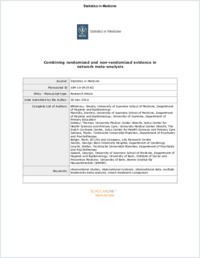Combining randomized and non-randomized evidence in network meta-analysis.
- Efthimiou O Department of Hygiene and Epidemiology, University of Ioannina School of Medicine, Ioannina, Greece.
- Mavridis D Department of Hygiene and Epidemiology, University of Ioannina School of Medicine, Ioannina, Greece.
- Debray TP Julius Center for Health Sciences and Primary Care, University Medical Center Utrecht, Utrecht, The Netherlands.
- Samara M Department of Psychiatry and Psychotherapy, Technische Universität München, München, Germany.
- Belger M Eli Lilly and Company, Lilly Research Centre, Windlesham, U.K.
- Siontis GC Department of Cardiology, Bern University Hospital, Bern, Switzerland.
- Leucht S Department of Psychiatry and Psychotherapy, Technische Universität München, München, Germany.
- Salanti G Department of Hygiene and Epidemiology, University of Ioannina School of Medicine, Ioannina, Greece.
- 2017-01-14
Published in:
- Statistics in medicine. - 2017
cohort studies
mixed treatment comparison
multiple treatments meta-analysis
observational data
observational evidence
observational studies
Clinical Trials as Topic
Data Interpretation, Statistical
Humans
Models, Statistical
Network Meta-Analysis
Randomized Controlled Trials as Topic
Statistics as Topic
Treatment Outcome
English
Non-randomized studies aim to reveal whether or not interventions are effective in real-life clinical practice, and there is a growing interest in including such evidence in the decision-making process. We evaluate existing methodologies and present new approaches to using non-randomized evidence in a network meta-analysis of randomized controlled trials (RCTs) when the aim is to assess relative treatment effects. We first discuss how to assess compatibility between the two types of evidence. We then present and compare an array of alternative methods that allow the inclusion of non-randomized studies in a network meta-analysis of RCTs: the naïve data synthesis, the design-adjusted synthesis, the use of non-randomized evidence as prior information and the use of three-level hierarchical models. We apply some of the methods in two previously published clinical examples comparing percutaneous interventions for the treatment of coronary in-stent restenosis and antipsychotics in patients with schizophrenia. We discuss in depth the advantages and limitations of each method, and we conclude that the inclusion of real-world evidence from non-randomized studies has the potential to corroborate findings from RCTs, increase precision and enhance the decision-making process. Copyright © 2017 John Wiley & Sons, Ltd.
- Language
-
- English
- Open access status
- green
- Identifiers
-
- DOI 10.1002/sim.7223
- PMID 28083901
- Persistent URL
- https://folia.unifr.ch/global/documents/268068
Statistics
Document views: 22
File downloads:
- fulltext.pdf: 0
